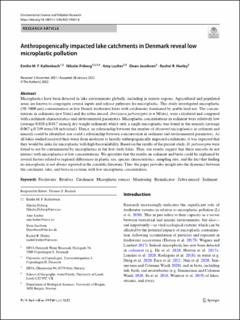| dc.contributor.author | Kallenbach, Emilie | |
| dc.contributor.author | Friberg, Nikolai | |
| dc.contributor.author | Lusher, Amy | |
| dc.contributor.author | Jacobsen, Dean | |
| dc.contributor.author | Hurley, Rachel | |
| dc.date.accessioned | 2022-03-24T12:18:03Z | |
| dc.date.available | 2022-03-24T12:18:03Z | |
| dc.date.created | 2022-02-24T12:32:32Z | |
| dc.date.issued | 2022 | |
| dc.identifier.citation | Environmental science and pollution research international. 29, 47726-47739, 2022. | en_US |
| dc.identifier.issn | 0944-1344 | |
| dc.identifier.uri | https://hdl.handle.net/11250/2987358 | |
| dc.description.abstract | Microplastics have been detected in lake environments globally, including in remote regions. Agricultural and populated areas are known to congregate several inputs and release pathways for microplastic. This study investigated microplastic (50–5000 µm) contamination in five Danish freshwater lakes with catchments dominated by arable land use. The concentrations in sediments (n = 3/site) and the zebra mussel, Dreissena polymorpha (n = 30/site), were calculated and compared with catchment characteristics and environmental parameters. Microplastic concentrations in sediment were relatively low (average 0.028 ± 0.017 items/g dry weight sediment) whilst only a single microplastic was found in the mussels (average 0.067 ± 0.249 items/10 individual). Hence, no relationship between the number of observed microplastics in sediment and mussels could be identified, nor could a relationship between concentration in sediment and environmental parameters. As all lakes studied received their water from moderate to heavily anthropogenically impacted catchments, it was expected that they would be sinks for microplastic with high bioavailability. Based on the results of the present study, D. polymorpha were found to not be contaminated by microplastics in the five study lakes. Thus, our results suggest that these mussels do not interact with microplastics at low concentrations. We speculate that the results on sediment and biota could be explained by several factors related to regional differences in plastic use, species characteristics, sampling size, and the fact that finding no microplastic is not always reported in the scientific literature. Thus, the paper provides insight into the dynamics between the catchment, lake, and biota in systems with low microplastic concentration. | en_US |
| dc.language.iso | eng | en_US |
| dc.publisher | Springer | en_US |
| dc.rights | Navngivelse 4.0 Internasjonal | * |
| dc.rights.uri | http://creativecommons.org/licenses/by/4.0/deed.no | * |
| dc.title | Anthropogenically impacted lake catchments in Denmark reveal low microplastic pollution | en_US |
| dc.type | Peer reviewed | en_US |
| dc.type | Journal article | en_US |
| dc.description.version | publishedVersion | en_US |
| dc.rights.holder | © The Author(s) 2022 | en_US |
| dc.source.pagenumber | 14 | en_US |
| dc.source.volume | 29 | |
| dc.source.journal | Environmental science and pollution research international | en_US |
| dc.identifier.doi | 10.1007/s11356-022-19001-8 | |
| dc.identifier.cristin | 2005119 | |
| cristin.ispublished | true | |
| cristin.fulltext | original | |
| cristin.qualitycode | 1 | |

